Moving To Maine
New Wildlife Species Feeling the Heat
by Tom Seymour
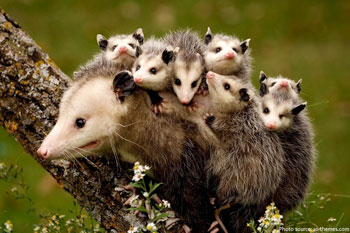
Main predators of opossums are dogs, foxes, coyotes, bobcats, hawks and owls. But even more than these natural predators, their greatest enemy in the modern world is the automobile.
Not too many years ago, a lobsterman was hauling traps and looking toward shore, spotted a large, all-white, wading bird. It was an egret, a bird whose northernmost range has now expanded so that it is common from one end of Maine’s rock-studded coast to the other. This was not always so. Nonetheless, today, snowy egrets, cattle egrets and great egrets are all present in Maine.
Things change quickly regarding range maps for not only egrets, but a host of other wildlife species. Those who maintain bird-feeding stations know only too well that many songbirds they had never before seen have now become regulars at the feeder.
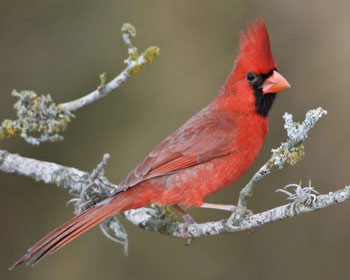
Northern Cardinal
It was only two years ago that tufted titmice, small birds with large, black, Orphan-Annie eyes and a crest atop their heads showed up at the author’s suet feeder. In speaking with other birdwatchers, it was found that titmice were already present in some sections of Central and Midcoast Maine. But now their range has expanded and it appears likely that soon, these songbirds will become even more widespread.
Tufted titmice aren’t the only newcomers. Northern cardinals, “red” cardinals as many people call them, have greatly expanded their range northward and have become common visitors to feeding stations. These colorful birds are quite welcome, mostly for their bright coloration and also, their gentle disposition.
TV Dinners
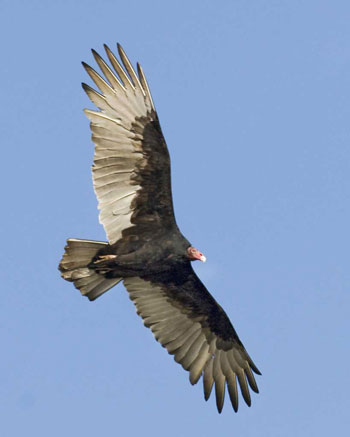
Turkey Vulture
Most people immediately assign the reason for wildlife species northward movement as a sign of global warming. But in the case of turkey vultures, those huge birds that soar on thermals, their wings held at a dihedral, a warming climate was not so much responsible for their northward trek as was the Interstate Highway system.
Why the Interstate? Because of the easy availability of road-killed animals. Turkey vultures feed on carrion and they can detect it from incredible distances. This has given rise to the term “TV dinners” (turkey vulture dinners) as applied to roadkill.
Turkey vultures are migratory, leaving Maine each fall, to return again the following spring. It’s easy to plot turkey vulture arrivals by keeping track of the diminishing snowpack. As the snow leaves roadsides sometime in March, at least in much of Maine, turkey vultures hang close to the edge of the retreating snow cover.
Black sea bass feed on
fish, mussels, clams,
shrimp and
juvenile lobster.
Until sometime in the 1970s, most Mainers had never seen a turkey vulture. Back then, a story in a Midcoast newspaper recounted a farmer’s tale of his encounter with a turkey vulture. The farmer was driving his tractor on a back field and noticed a large object on a manure pile. Getting off the tractor and walking toward the thing, the farmer saw that it was some kind of large bird.
When the farmer had approached to within a stone’s throw of the bird, the vulture acted aggressively, according to the farmer, vocalizing with guttural croaks. That was enough for the farmer and he ran to his tractor and left the area. Today, turkey vultures are as common as robins and no one gives them a second thought. And no, turkey vultures are not really aggressive. The farmer in the story over-reacted because he didn’t know what he was dealing with.
Real Turkeys
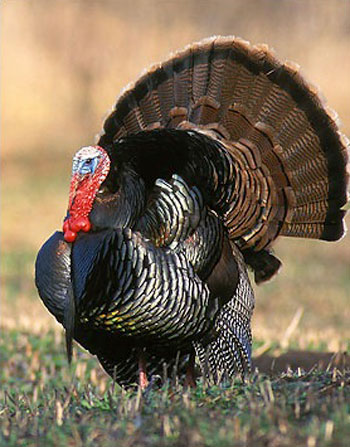
Wild turkey
Wild turkeys, not turkey vultures but real turkeys, were extirpated from Maine many years ago. But a re-introduction program in the late 1970s and early 1980s has brought these prolific birds back to Maine in a big way.
At first, the birds were protected so as to assure their survival. But wild turkeys soon became established to a point that a limited hunting season was initiated. And now wild turkeys have become so widespread that they rank as nuisance animals. Because of this, hunting regulations were liberalized. Even so, many people have raised a hue and cry for even more lenient hunting laws.
Anyone who has had a flock of wild turkeys rolling around in their gardens and breaking down young plants, or who was bedeviled by wild turkeys fouling the area around their bird feeders can probably sympathize with those who consider wild turkeys as some kind of plague.
Hello, Pogo
Possums have slowly
infiltrated the state
and have become
fairly common.
Birds aren’t the only newcomers to Maine. A new, four-legged critter now calls Maine home. Virginia opossums, or simply, ‘possums, have slowly infiltrated the state and have become fairly common, especially in southern and coastal regions.
Opossums are our only North American marsupial. Opossum young are born prematurely and after that, finish their early development in a special pouch on the mother’s belly.
In addition to this, ‘possums have prehensile tails, which allow them to hang on tree branches. As recently as 1980, a range map in the Peterson Field Guide to Mammals indicated ‘possum’s northernmost range as being in southern New Hampshire and Vermont, but not Maine. Today, ‘possum sightings in Maine no longer raise eyebrows.
Slow-moving ‘possums show up as roadkill and pancake-flat possums dot our roadways. Remember that old joke that goes, “The highway of life is littered with flat squirrels that couldn’t make up their minds?” Well, today we can easily substitute ‘possums for squirrels. Opossums also show up around human habitations, where they raid trash cans, bird feeders and even visit decks and porches to chow down on food left outside for housecats.
The woolly substance
covers the mature insect
and is impossible
to miss.
One Waldo County ‘possum became a regular visitor to a feeding station set up for neighborhood cats. Amazingly, the cats did not fear the ‘possum, nor did the ‘possum evidence any aversion to the cats. The two different species calmly shared their plates of cat food, with no pushing, shoving or growling from either side.
Frostbite has become a problem for ‘possums living in our cold, Maine climate. During extremely cold spells, opossum’s naked tails and ears sometimes become frostbitten and by spring, the animals acquire a rather dilapidated appearance.
Maine’s Department of Inland Fisheries & Wildlife has instituted a hunting season on opossums. There is no bag limit.
Insects, Too
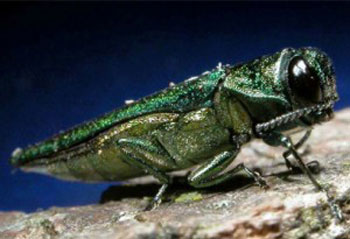
Emerald ash borer
A horribly destructive insect pest has finally arrived in Maine. On May 22, 2018, emerald ash borers, a colorful beetle that destroys all varieties of ash trees, was noted in Madawaska, in Aroostook County.
This was devastating news, since ash trees are vital to at least a small sector of the Maine economy. Maine Indians weave beautiful, collectors-item baskets out of splits taken from brown ash, a small ash tree with cork-like bark. Brown ash’s annular rings separate easily, which makes it such a good choice for basketmaking. Besides brown ash, white ash ranks as an important firewood source, as well as the source for baseball bats, snowshoes, furniture and other handmade craft items.
To lose all of Maine’s ash would rank as a catastrophic event. Accordingly, the State of Maine forbids the importation of firewood to the state. But with emerald ash borers now present in Aroostook County and also, neighboring New Hampshire, the future of Maine ash trees looks grim. For those who think they may have observed an emerald ash borer, the State of Maine has complete and detailed information available. A special chart also includes similar species to further aid in making a positive identification. To see this chart, go online to: maine.gov/dacf/php/caps/EAB/EABid.shtml. Another option is to simply type in, “emerald ash borer” in a search engine. Reams of information will become immediately available.
Another destructive insect pest now lives in coastal sections of Maine. These appear as small, white, woolly objects on new hemlock growth. The pest, hemlock woolly adelgid, is present year-round but is most visible in spring.
The woolly substance covers the mature insect and is impossible to miss when present. The insects suck hemlock sap and inject a toxic substance when feeding. Damage causes leaves, or “needles,” to dry up and fall from the branch. This also kills buds and so the tree cannot regenerate. Limbs slowly die off, beginning with the lower limbs and progressing upward. Infected trees eventually fall prey to boring insects. The tree becomes even more brittle and is easily upended by windstorms. Either way, left unchecked, a woolly adelgid infestation means the hemlock tree is doomed.
Saltwater Fish
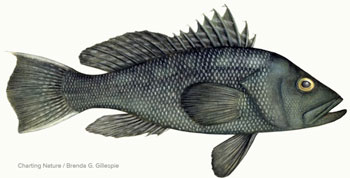
Black sea bass
A new saltwater fish has made inroads in Maine waters. Black sea bass, which is highly prized by restaurants and represents a considerable commercial fishery in southern New England, now swims in Maine waters.
These spiny-rayed fish, which average about 1-1/2 pounds and can grow to 8 pounds, recently began showing up in lobster traps. Since black sea bass are a desirable commercial and sport fish, this might sound like a good thing. But their presence is really a double-edged sword. Black sea bass feed on fish, mussels, clams, shrimp and juvenile lobster. The extent of depredation on lobster by black sea bass remains yet a mystery. Possibly, it is insignificant. On the other hand it may be a catastrophe waiting to happen.
Black sea bass are migratory in that they move to offshore waters in fall, staying at depths from 240 to 540 feet. Then in spring, the fish move inshore to shallow water, where they sometimes enter lobster traps. Black sea bass were typically absent from waters north of Cape Cod, but now the tasty predators have moved into Maine waters.
By now it’s plain to see that big changes have come to Maine fauna. Given this, it seems reasonable to expect that new species will continue to migrate northward. Looking forward, then, nothing should surprise us. And how this growing body of new wildlife species will reshape Maine’s natural environment is anyone’s guess. But all we can do is hope for the best and keep our eyes open for the next wild visitor to show up. At the very least, this is an interesting topic and one that we should all keep track of.
